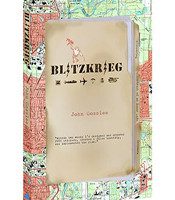Strangely, with the entire multimodal dazzle that adorns Blitzkrieg, the poems of John Gosslee exist in a vestigial nook, a calm ache of textual space blissfully unaware of the ripples created by its presence. This is not a criticism. Rather it is an attempted elucidation of the juxtaposition inherent in such an ambitious project. Less a book, and more a sensory experience, the collection comes paired with a soundtrack by the composer Taras Mashtalir and a movie by Thomas Agostino. Several pages are also illustrated, including several by Scott Kirschner and The Rumpus artist Yumi Sakugawa.
With so much going on, does the metaphorical blitzkrieg work? For the most part, the answer is yes. The poems lay a sturdy foundation for the rest of the book-experience. Divided into the three sections, the collection begins with a chapbook’s worth of lyrical list-poems buoyed by narratives rendered so crystalline that you can see the grain of the words. Take this one, for example:
Some People Watch it and Fall in Love Again
my torso heaves a cage full of birds in a tornado
I am like a dog roaming from yard to yard
the thumb-nail-width left between two stars
she is the first person to look at me all night
I stop like an axe flung into a tree
she lunges to pluck me down and catches air
my mouth opens a door into the night
her arms like a drawbridge over a river rise
I am imprinted in the valleys and on the peaks
she tears off her wings for me
her songs teach the leaves to fall
the stars like god’s spit glisten
Almost all of the poems elide punctuation and beget line after line of surreal uncertainty. You can detect an indeterminate beauty on the page, crafted out of the residual pastoral elements remaining in cityscapes. Aware of the power of this idea, Gosslee repeats it again and again.
When we reach part two of the book, the nature of what this project is about begins to change. There is substantial buildup dedicated to one poem:
Portrait of an Inner Life
a mansion
inside a hovel
an elephant
trapped in a swallow
the claw at the end
of a roar
a frame
without a door
At sixteen pages, the essay—the “migration”—is perhaps overlong, and much of the minutiae surrounding the poem’s journey and multiple readings is of limited interest, aside for the most ardent lover of “Portrait of an Inner Life.” The essay, though, does contain a fascinating backstory of the poem’s physical distribution. Two thousand stickered copies were sealed inside bottles and flung into a variety of rivers across the country (photographs of which are included) or posted in public places. If found, people were asked to snap a picture of the poem and share the image with others. Across the U.S. this experiment was repeated hundreds of times, and the essay supplies the details of this nationwide poetry event.
Gosslee quotes Rattle editor Timothy Green’s insightful analysis of the poem: “could be a new eastern form, if we wanted it to be—a variation on the Renku, perhaps. Each couplet is a pair of images, the second always undercutting the first and rendering the whole impossible—a series of slender koans on the nature of self.” Green’s remarks can be seen to take hold in part three, in the two sets of illustrations that offer competing visions of the stanzas. Yumi Sakugawa uses simple pen marks, scratchy and illuminating in the forming of an elephant’s eye or a blank swallow. There is also room for the nightmarish interpretations of Scott Kirschner. His macabre paintings are vicious, cutting, and quite different to the serenity of the poem. Yet, like the poem itself, they work, they entice and provoke.
The soundtrack that accompanies the book mirrors the tripartite structure. Created by Taras Mashtalir, part one contains a collection of electronic bleeps and a mildly evil robotic voice. This sonic attack is less catchy than Daft Punk, and I had a hard time marrying the soundtrack to the poems. I found it an uncomfortable experience—no doubt the point—to listen and read at the same time. The second part is more sedate and features a voice reading sections of the poems drummed on by a lo-fi beat. By the time the listener gets to the last section, he is rewarded with an uplifting, haunting composition joined with a human voice reading another surreal narrative. The soundtrack on its own terms is interesting and well worth a listen, finding ground, as it does, closer to conceptual art than commercial music.
Blitzkrieg marks a bold step forward from 12: Sonnets for the Zodiac. Indeed, it reads like an announcement, a broadside that crosses the limitations of genre and dares to invade the cultural spaces and formulas of contemporary art and poetry. The film charting the whole Blitzkrieg experiment was released in December.




